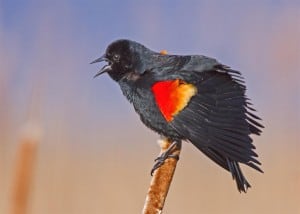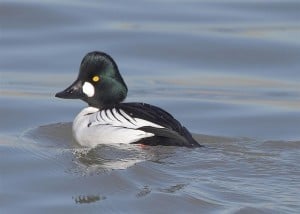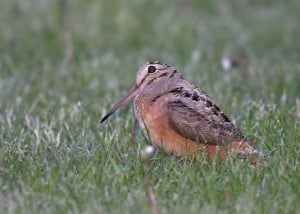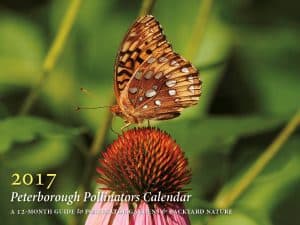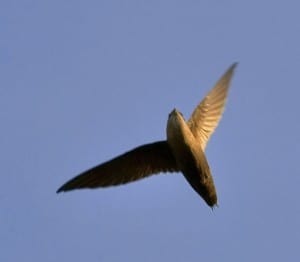As we turn the corner into spring, let’s pause a moment to reflect back on the winter that’s been. For many people, the temperate weather was a blessing, with only moderate snowfall and temperatures well above average. Yes, the abnormally mild winter did make life easier for most of us. At the same time, however, any remaining climate skeptics need to accept the weather – both locally and continent-wide – for what it really was: yet more proof of climate change and climate chaos.
Record-warm temperatures and extreme weather events were the pattern across North America. While California received a deluge of biblical proportions and Arctic winter sea ice dwindled to record lows, a “record-setting record” was being established across the entire U.S. and much of Canada. No fewer than 1,151 record highs were set in the U.S. in February, compared to only two record lows. This translates into a 575-to-1 ratio of highs to lows, which is believed to be a record for the most lopsided monthly ratio in U.S. history. An increasing ratio of this kind is a hallmark of climate change. If the planet wasn’t warming, that ratio should remain constant at about 1-to-1. With each passing decade, record highs are outpacing record lows at an ever-increasing rate.
Since August 2015, only one month in the Kawarthas has been cooler than average. This past January and February were both nearly 5 C above normal. Not surprisingly, many migrants returned two to three weeks earlier than usual. The last days of February saw the arrival of turkey vultures, common grackles, red-winged blackbirds and killdeer – species we usually don’t see until the third week of March. As for robins, well, they had never left. Record numbers chose to overwinter in the Kawarthas this year, thanks mostly to the huge crop of wild grape.
Early bird arrivals were only part of the “spring in February” story. Maple syrup producers in central Ontario were collecting and boiling sap two to three weeks earlier than usual; the buds scales of trembling aspens, pussy willows, lilacs and silver maple opened; and snowdrops and crocuses began to poke above the snow in many gardens. However, despite all the climate chaos we’ve been seeing, an EKOS poll found that Canadians are less concerned about climate change than they were a decade ago. I suspect that one reason for this sad state of affairs is that weather reports almost never mention climate change and always frame mild temperatures in a positive context. Other than the odd interview with meteorologist David Phillips of Environment Canada, when do you hear weathercasters alerting viewers to the connection between extreme weather and the rising concentration of greenhouse gases in the atmosphere? This is a shameful failure of weathercasters to fulfill their duty to the public. Imagine if doctors behaved this way with their patients!
With the caveat that climate change is disrupting the timing of events in nature, I would still like to remind readers of the mileposts of spring’s progression. Regardless of what the weather throws at us, the order of the events, which are listed chronologically, should remain the same.
Late March
· It’s time to start indoor sowing of annuals for your pollinator garden. Some great species include Mexican sunflower (Tithonia), common sunflower (Helianthus annuus) and catnips (Nepeta).
· For anyone paying attention, the increase in bird song is hard to miss. If you don’t already know the voices of common songsters like the American robin and the song sparrow, this is a great time to start learning them. Go to allaboutbirds.org, enter the name of the species, and click on the Sound tab.
· With a bit of work, you should be able to find a dozen or more species of migrating waterfowl. Some hotspots include Little Lake, the Otonabee River, the Lakefield sewage lagoon on County Road 33 and Clear Lake at Young’s Point. Watch for ring-necked ducks, buffleheads, lesser scaup, common goldeneye, and both common and hooded mergansers.
April
· April is a busy time for feeders. American tree sparrows, dark-eyed juncos and, later in the month, white-throated sparrows move north through the Kawarthas in large numbers. They can all be attracted by spreading millet or finch mix on the ground.
· The yellow, dandelion-like flowers we see growing in roadside ditches in early April are a non-native species known as coltsfoot.
· Peterborough Pollinators is hoping to see 150 pollinator gardens registered in Peterborough and area to help celebrate Canada’s 150th birthday. You can register an existing pollinator-friendly garden or commemorate the occasion by starting a new one. Go to PeterboroughPollinators.com/Register.
· The Peterborough Garden Show runs from April 7 to 9 at the Evinrude Centre. Don’t miss Cathy Dueck’s talk entitled “Pollinators: What Every Gardener Should Know” at 10:30 a.m. on April 9.
· Now is the time to put out nesting structures for stem-dwelling bee species. Commercially-made nests are available or you can make your own out of Phragmites stems. Seeds.ca/pollination is a great resource as is the 2017 Peterborough Pollinators Calendar, which is available at the Avant Garden Shop on Sherbrooke St. or by contacting Peterborough Pollinators.
· Close to 30 species of birds are nesting this month. Among these are Canada geese, mallards, bald eagles, mourning doves and American robins.
· For many rural residents, the return of the yellow-bellied sapsucker is hard to miss. This migratory woodpecker loves to hammer on resonant objects such as stovepipes to advertise ownership of territory and to attract a mate.
· If the weather is mild, local wetlands come alive in early April with the clamorous calls of countless frogs. The first voice usually heard is that of the chorus frog. Within a few days, wood frogs, spring peepers, and leopard frogs add their voices to the symphony. To learn amphibian calls, go to naturewatch.ca. In the menu at the top of the page, click on FrogWatch, then “How-to Guide”, followed by “Identifying Frogs”.
· Hepaticas are usually the first woodland wildflowers to bloom in the spring. The flowers can be pink, white or bluish in colour. The Stoney Lake Trails are a great place to see this species and many others. Park at 105 Reid’s Road.
· The courtship flight of the American woodcock provides nightly entertainment in damp, open field habitats such as fields at the Trent Wildlife Sanctuary.
May
· A variety of interesting butterflies is already on the wing as May begins. These include the Compton tortoiseshell, the eastern comma and the mourning cloak. Try walking the new, 1.5 kilometre interpretive trail in Kawartha Highlands Provincial Park, which was established by Ontario Parks with the help of the Buckhorn Trails Association. The trailhead is at the parking lot/boat landing off County Road 36, just north of Buckhorn. It provides an excellent example of The Land Between ecoregion.
· The yellow-gold flowers of marsh marigolds brighten wet habitats in early May. Later, white trilliums blanket woodlots throughout the Kawarthas. A closer look will reveal numerous other wildflowers, too, like yellow trout Lily. Ties Mountain Road north of Nogies Creek provides a great wildflower display.
· The first ruby-throated hummingbirds usually return on about May 5, so be sure to have your feeders ready to greet them. Keep your sunflower feeders well-stocked, too, since rose-breasted grosbeaks and indigo buntings may just pay you a visit.
· The long, fluid trills of the American toad can be heard day and night. They are one of the most characteristic sounds of early May. Later in the month, gray treefrogs serenade us with their slow, bird-like musical trills.
· Watch for native solitary bees in your garden and yard. Some common species include sweat, mason, carpenter and orchard bees. The Peterborough Pollinators calendar will help you identify these tiny pollinators.
· If you’re looking for pollinator plants for your garden, don’t miss the Peterborough Horticultural Society Plant Sale on May 13 at Westdale United Church (9 a.m. to noon) and the GreenUp Ecology Park sale on May 21 (noon to 4 p.m.)
· Mid-May is the peak of songbird migration with the greatest numbers of warblers, vireos, thrushes, orioles, flycatchers and other neo-tropical migrants passing through. Mild, damp mornings usually provide the best viewing conditions. Beavermead and Ecology Park can often be quite productive.
· Wild columbine blooms in late May on rocky hillsides and along roads and trails. The flowers, a beautiful blend of red and yellow, hang in bell-like fashion and are often visited by hummingbirds. The Nanabush Trail at Petroglyphs Provincial Park is worth checking out for late spring wildflowers, including pink lady’s slipper orchids.
· The showy, yellow and black Canadian tiger swallowtail butterfly appears by month’s end and adds an exotic touch to our gardens.
June
· In downtown Peterborough and Lakefield, Chimney swifts are putting on quite a show. Pairs can be seen in courtship flight as they raise their wings and glide in a V position.
· Painted and snapping turtles are often seen along roadsides and rail-trails laying their eggs. Please slow down in turtle-crossing zones and, if it is safe, help the reptile across the road.
· The first monarch butterflies are usually seen in June. Make sure you have some milkweed in your garden on which they can lay their eggs.
· The summer solstice occurs on June 21 at 12:24 AM. The sun will rise and set farther north than on any other day of the year. Celebrate this profound celestial event with your family.
